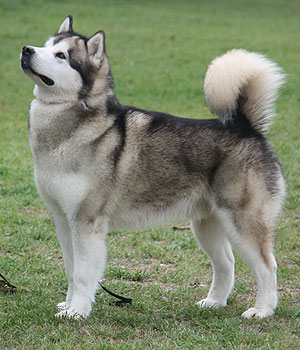Breed Info - Alaskan Malamute
Overview
|
Breed Group
Working Size Large How much exercise? More than 2 hours per day Length of coat Medium How much grooming? Every day |
Sheds?
Yes Town or Country Country Type of home Large House Minimum Garden Size Large Lifespan Over 10 Years |
Description
Affectionate, loyal, playful
Hailing from the rugged western area of Alaska, and taking his name from the Mahlemut peoples of the region, this dog has had to be hardy to stay alive. He is a really big dog, the male weighing well over 50 kilograms (110 pounds) and standing up to 71 centimetres (28 inches) at the shoulder. His purpose in life is to pull sledges, and he can cope with prodigious loads, though he is not designed to be a racer. Although he is a truly handsome fellow, he does not have the spectacular glamour of his smaller sledding cousins.
The Malamute is a Nordic-type dog who moved into the northern Polar regions when people began to occupy the land. The Mahlemut tribes were a hard-working and skilled Inuit (Eskimo) race who loved and cared for their dogs, which were first discovered by settlers in the 1750s. Though breed type was nearly lost by crossing with faster animals for sled racing, some Inuit continued to breed to type. Eventually promotion of the pure-bred Malamute was taken up by the American fancy.
His coat is thick in the coarse outer guard coat and in the woolly undercoat, so he doesn’t notice the cold and will curl up and sleep in a blizzard that would send lesser canines running for shelter. Not only massively built, the Malamute is also dignified; this does not mean he lacks a sense of play, but he sometimes doesn’t know his own strength. If he takes off after another dog, his handler needs good brakes. Being large, he requires plenty of food for energy. Though he is not particularly fleet of foot, he likes his exercise and is not a dog for the lazy.
Affectionate, loyal, playful
Hailing from the rugged western area of Alaska, and taking his name from the Mahlemut peoples of the region, this dog has had to be hardy to stay alive. He is a really big dog, the male weighing well over 50 kilograms (110 pounds) and standing up to 71 centimetres (28 inches) at the shoulder. His purpose in life is to pull sledges, and he can cope with prodigious loads, though he is not designed to be a racer. Although he is a truly handsome fellow, he does not have the spectacular glamour of his smaller sledding cousins.
The Malamute is a Nordic-type dog who moved into the northern Polar regions when people began to occupy the land. The Mahlemut tribes were a hard-working and skilled Inuit (Eskimo) race who loved and cared for their dogs, which were first discovered by settlers in the 1750s. Though breed type was nearly lost by crossing with faster animals for sled racing, some Inuit continued to breed to type. Eventually promotion of the pure-bred Malamute was taken up by the American fancy.
His coat is thick in the coarse outer guard coat and in the woolly undercoat, so he doesn’t notice the cold and will curl up and sleep in a blizzard that would send lesser canines running for shelter. Not only massively built, the Malamute is also dignified; this does not mean he lacks a sense of play, but he sometimes doesn’t know his own strength. If he takes off after another dog, his handler needs good brakes. Being large, he requires plenty of food for energy. Though he is not particularly fleet of foot, he likes his exercise and is not a dog for the lazy.
| |||


